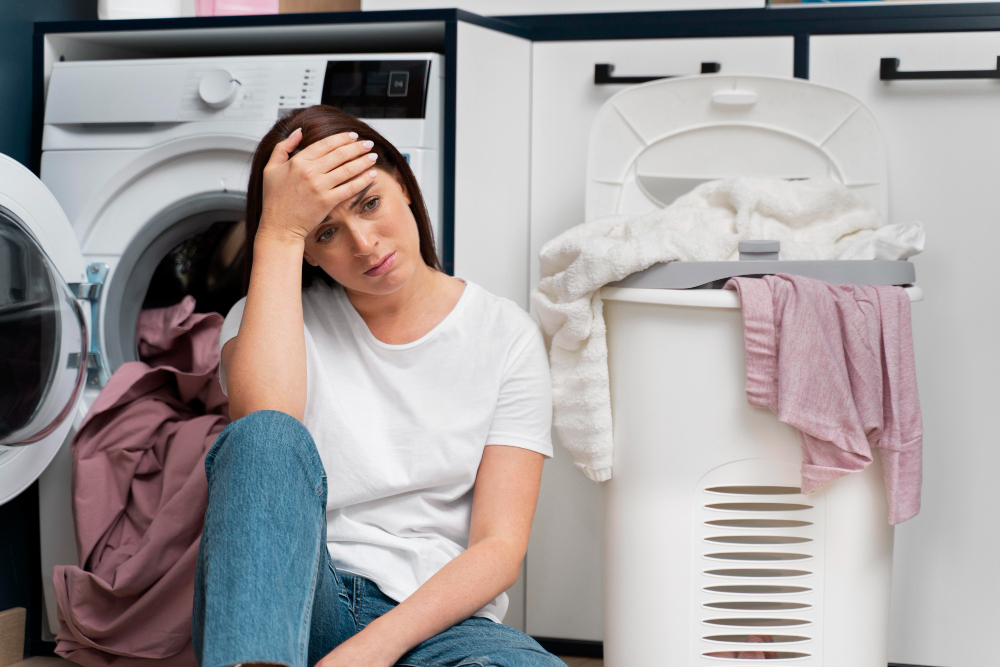Table of Contents
What Does the OE Error Code Mean?
The OE error code on your LG washer is a signal that your machine is having trouble draining the water. “OE” stands for “Overflow Error,” which might sound more dramatic than it is. Essentially, it’s your washer’s way of telling you that water isn’t exiting the machine as it should. This could be due to a variety of reasons, which we’ll explore next.Why Is the OE Error Code a Problem?
So, why should you care about this error code? Well, a washer that can’t drain properly can lead to bigger issues:- Potential Damage: Water left in the washer can damage its internal components.
- Inconvenience: A washer that stops mid-cycle is a hassle, leaving you with half-done laundry.
- Efficiency Loss: Your washer can’t perform optimally, leading to potential wear and tear and higher utility bills.
Best ways to Fix OE Error Code LG Washer
The washer is unable to drain water efficiently or completely before proceeding to the next operation. This problem can be caused by a variety of factors, including a clogged drain hose or filter, a faulty sump pump, or even improper installation of the device. As you can imagine, improper drainage can cause more problems inside your washer and affect its performance and durability.- Clear The Drain Filter of Debris and Lint
- Straighten and Unblock The Drain Hose: Disconnect your LG Washer >Access the Drain Hose >Inspect for Blockages >Clean out Blockages >Examine for Kinks and Dents >Reattach Drain Hose >Reconnect and Test Your Washer.
- Inspect the Connection Between the Drain Hose and Pump for Blockages: Turn off and unplug your LG washer >Locate the drain pump filter >Prepare for water spillage >Release and disconnect the drain hose >Inspect both ends of the detached hose >Inspect the drain pump opening >Reconnect the hose to the pump >Reassemble your LG washer.
- Check the Drain Pump for Damage or Malfunctions: Unplug your LG washer >Locate the drain pump >Check for any visible damage >Test for potential malfunctions >Reassemble the washer >Test your washer.
- Remove Any Foreign Objects Obstructing the Tub or Impeller Area: Unplug the washer >Access the Tub >Remove Objects From Drum Holes >heck Impeller Area and Filter Assembly >Removing Obstructions from Impeller Area >Reassemble Filter Assembly >Plug the Washer and Run a Test Wash.
- Clean the Door Seal, Removing any Accumulated Dirt or Grime: Gather the necessary tools and materials >Turn off and unplug your LG washer >Open the washer door >Inspect the door seal >Prepare your cleaning solution >Clean the door seal >Rinse thoroughly >Dry the door seal >Reconnect your LG washer.
- Reinstall the Washer to Ensure a Proper Leveling Position: Unplug and disconnect your washer >Pull out the washing machine >Check for unevenness >Adjust the leveling legs >Double-check your adjustments >Lock the legs >Reconnect your washer and test it.
- Test for Issues in your Plumbing Beyond the Washer’s Connections: Verify if other fixtures have drainage problems >Examine visible pipes for damage >Inspect for possible clogs >Consult a professional plumber
Reset your LG Washer by Unplugging it and Plugging it back in after a Couple of Minutes. - Perform Regular Maintenance to Prevent Recurrent OE Error Code Occurrences: Schedule Periodic Cleanings >Empty and Clean the Drain Filter >Inspect and Straighten the Drain Hose >Evaluate Tub Area and Door Seal >Run Cleaning Cycles >Examine External Plumbing Sources >Keep an Eye on the Leveling Position.
Common Causes of the OE Error Code
Understanding why this error occurs is the first step in fixing it. Here are some usual suspects: Blocked Drain Hose: A kinked or clogged drain hose is one of the most common reasons for the OE error code. If water can’t pass through the hose, it backs up into the washer. Clogged Pump Filter: Your washer has a pump filter to catch debris and prevent it from entering the drain hose. Over time, this filter can get clogged with lint, hair, and other debris. Malfunctioning Drain Pump: The drain pump is responsible for pushing water out of the washer. If it fails, water won’t drain, and the OE error code will appear. Issues with the Control Board: In rare cases, the control board (the washer’s “brain”) might malfunction, incorrectly signaling the OE error.How to Diagnose the OE Error Code
Before you start dismantling your washer, let’s take a methodical approach to diagnosing the issue:- Initial Checks
- Ensure the washer is off and unplugged.
- Have a towel and a bucket handy to catch any water spills.
- Tools You Might Need
- Screwdrivers
- Pliers
- A flashlight
- A multimeter (for electrical testing)
How to Fixing the OE Error Code
By addressing the cause of the problem, you can effectively resolve the problem, extend the life of your washer, and maintain smooth wash cycles for years to come. The next time you encounter his OE error code on your LG washing machine, remember that you don’t have to feel helpless or overwhelmed. Ready to get your hands dirty? Here’s a detailed guide to fixing the OE error code:Checking the Drain Hose:
- Locate the Hose: Find the drain hose at the back of your washer.
- Inspect for Kinks: Straighten any kinks or bends.
- Clean the Hose: Detach the hose and run water through it to clear any blockages.
Inspecting and Cleaning the Pump Filter:
- Access the Filter: Usually located at the front bottom of the washer.
- Remove the Filter: Twist it out carefully.
- Clean the Filter: Remove any debris and rinse under running water.
Testing the Drain Pump:
- Access the Pump: You might need to remove the back panel of the washer.
- Check for Obstructions: Ensure nothing is blocking the pump impeller.
- Test the Pump: Use a multimeter to check for electrical continuity. If the pump is faulty, it might need replacing.
Resetting the Control Board:
- Unplug the Washer: Leave it unplugged for about 10 minutes.
- Plug it Back In: Sometimes, a simple reset can clear the error.
Preventive Measures to Avoid the OE Error Code
Preventing the OE error code is easier than dealing with it. Here are some tips: Regular Maintenance:- Clean the Pump Filter: Check and clean it every few months.
- Inspect the Drain Hose: Make sure it’s free from kinks and blockages.
- Use Appropriate Detergent: Excess suds can contribute to drainage issues.
- Don’t Overload the Washer: Follow the manufacturer’s load size recommendations.
When to Call a Professional
Sometimes, despite your best efforts, the OE error code persists. Here are signs you need a pro:- Persistent Error Code: If the code keeps reappearing after troubleshooting.
- Strange Noises: Unusual sounds from the pump might indicate a mechanical issue.
- Water Leaks: If you notice water leaking from the washer.
Common Misconceptions About the OE Error Code
There are a few myths floating around about the OE error code:- “It’s Always a Major Issue”: Often, it’s something simple like a clogged filter.
- “Only Professionals Can Fix It”: Many fixes are DIY-friendly.
- “The Washer Needs Replacement”: Usually, the washer itself is fine with minor repairs.

